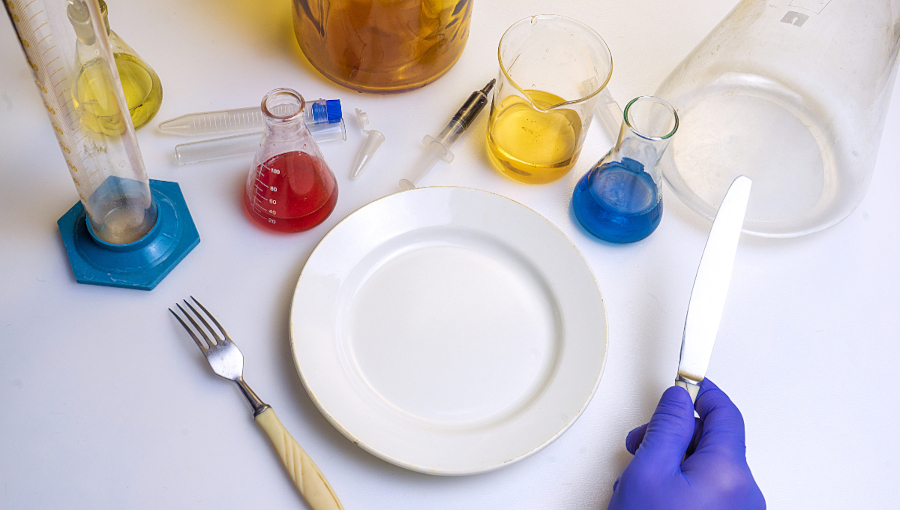You may be surprised to know that many of the foods you eat have chemicals in them. While we are told that the use of chemicals in food production is regulated, is that enough to make you feel comfortable eating foods with chemicals? In this article we provide information on some chemicals that have raised concerns in the past. These chemicals carry potential risks. Here are 10 such chemicals and the types of foods they have been used in:
-
Bisphenol A (BPA):
BPA is an industrial chemical that has been used in the production of certain plastics and epoxy resins. It has been found in the linings of some food and beverage cans, including canned fruits, vegetables, and beverages. BPA has been linked to potential health risks, including disruption of hormone function, reproductive issues, developmental effects, and increased risk of certain cancers. It is considered an endocrine disruptor.
-
Perfluorooctanoic acid (PFOA):
PFOA is a synthetic chemical that has been used in the production of non-stick coatings like Teflon. It has been detected in some fast-food wrappers, microwave popcorn bags, and grease-resistant food packaging. PFOA exposure has been associated with potential negative effects on the liver, thyroid function, immune system, and reproductive health. It is also suspected to have carcinogenic properties.
-
Polychlorinated biphenyls (PCBs):
PCBs are a group of synthetic chemicals that were once used in electrical equipment and as additives in certain industrial processes. Although their production has been banned, they may still be found in certain fish and seafood due to bioaccumulation in the environment. PCBs have been linked to adverse health effects, including developmental and neurological problems, immune system suppression, reproductive issues, and an increased risk of certain cancers.
-
Phthalates:
Phthalates are a group of chemicals used to soften plastics and improve flexibility. They have been found in food packaging materials, including plastic wrap and containers, as well as in some dairy products and fatty foods. Some phthalates have been associated with potential hormone disruption, reproductive issues, developmental effects, and adverse impacts on the liver, kidney, and respiratory system.
-
Artificial food colourings:
Various artificial food colourings, such as Red 40, Yellow 5, and Blue 1, are used to enhance the appearance of many processed foods, including candies, soft drinks, cereals, and baked goods. Some studies suggest a potential association with hyperactivity and behavioural issues in children, as well as allergic reactions in sensitive individuals.
-
Sodium Nitrite:
Sodium nitrite is a preservative commonly used in processed meats, such as bacon, hot dogs, and deli meats. It is used to help prevent bacterial growth and give meat a pink colour but has been associated with potential health risks. Consumption of excessive amounts of sodium nitrite, particularly from processed meats, has been associated with an increased risk of certain cancers, such as colorectal cancer.
-
Monosodium Glutamate (MSG):
MSG is a flavour enhancer used in many processed foods, including soups, snack foods, frozen dinners, and fast-food items. Some individuals may be sensitive to it and experience symptoms like headaches or flushing. MSG has been linked to the occurrence of symptoms such as headaches, flushing, sweating, and numbness in sensitive individuals, a condition known as “Chinese Restaurant Syndrome.”
-
Artificial Sweeteners:
Various artificial sweeteners, such as aspartame, saccharin, and sucralose, are used in sugar-free or low-calorie products like diet sodas, sugar-free desserts, and tabletop sweeteners. Some studies suggest an association between artificial sweetener consumption and increased appetite, weight gain, and metabolic disorders.
-
Butylated hydroxyanisole (BHA) and Butylated hydroxytoluene (BHT):
BHA and BHT are synthetic antioxidants used to prevent food spoilage and extend shelf life. They can be found in a range of processed foods, including cereals, snack foods, and baked goods. BHA and BHT have been studied for their potential carcinogenic and tumour-promoting properties.
-
Potassium Bromate:
Potassium bromate is a flour improver used to strengthen dough and enhance bread volume. Although its use is banned in several countries, it may still be found in some bread and bakery products. Potassium bromate is classified as a possible human carcinogen based on animal studies, and it has been linked to an increased risk of kidney and thyroid tumours. Its use is banned or heavily restricted in several countries due to these concerns.
It is important to note that the potential health risks associated with these chemicals are based on scientific studies and evaluations. Chemicals have no place in the human body.
This article is copyrighted by Ital is Vital, 2025. Want to re-post this article? Visit our guidelines.
DISCLAIMER: THIS WEBSITE DOES NOT PROVIDE MEDICAL ADVICE
The information, including but not limited to, text, graphics, images and other material contained on this website are for informational purposes only. The purpose of this website is to promote broad consumer understanding and knowledge of various health topics. It is not intended to be a substitute for professional medical advice, diagnosis or treatment. Always seek the advice of your physician or other qualified health care provider with any questions you may have regarding a medical condition or treatment and before undertaking a new health care regimen, and never disregard professional medical advice or delay in seeking it because of something you have read on this website.

Pingback: How Your Workout Clothes Could Be Doing You Some Harm - ital is vital
Pingback: Chemical Hair Relaxers Carry an Increased Risk of Uterine Cancer - ital is vital